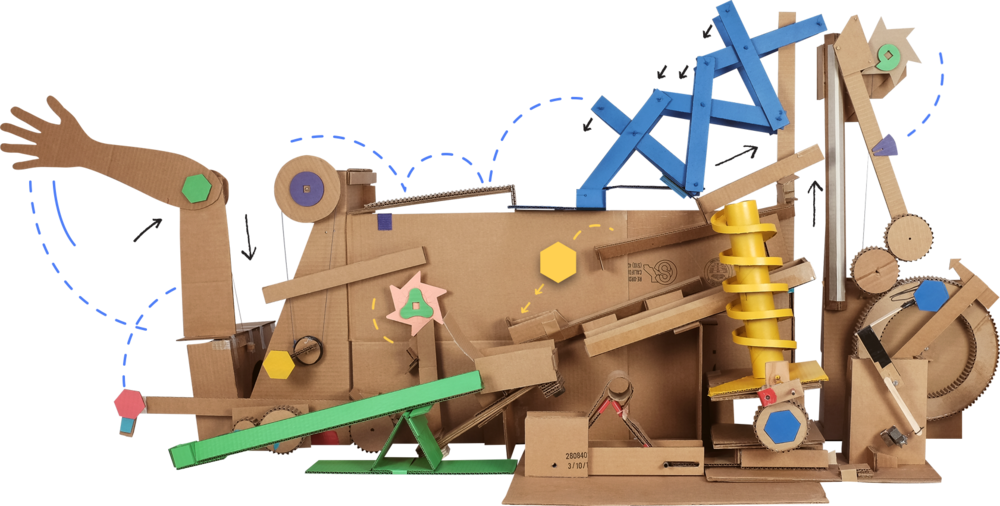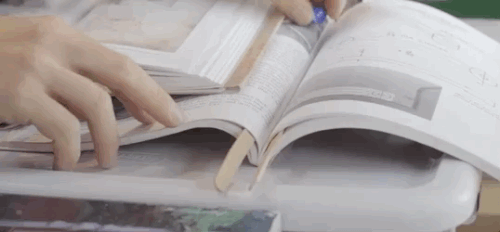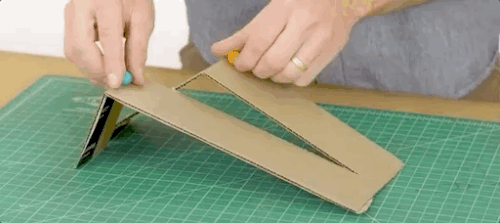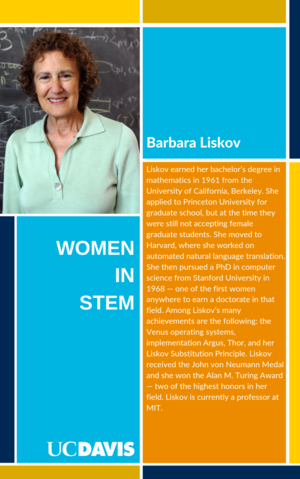Chain Reaction Challenge Part 2
Invent a wacky multi-step machine to complete a simple task
SESSION ROLES:
🐙 = Site Coordinator
🦉= Mentor

Notes for Site Coordinators and Mentors:
-
This challenge is structured as two individual 2hr sessions. This session is Part 2 of the Chain Reaction Challenge.
-
This session guide provides a detailed outline for part 2 of the Chain Reaction Challenge, but feel free to improvise or put your own spin to things. If you have an idea for a challenge or prompt that will get students excited, go for it! If something is not working well, change course and experiment another path forward. If you do change things up, we would love to hear what has been successful for you!
Session Overview
The Chain Reaction Challenge is structured as two individual 2hr sessions. This session is Part 2 of the Chain Reaction Challenge.
Inspired by Rube Goldberg, this session challenges students to explore a variety of mechanical interactions and solve a very simple problem in a wacky and complex way.
Students will brainstorm ideas and then use the littleBits Invention Cycle to perform a simple task with a chain reaction contraption. Then they will build and test multiple prototypes of their favorite idea. At the close of the session, students will create videos or cartoons of their chain reaction contraption in action.
As an added challenge, combine multiple group’s contraptions together for a mega reaction!
Session Details
Difficulty:
Intermediate
Duration:
2 hours
Subjects:
Engineering
Art/Design
Science
Prerequisite Knowledge:
Chain Reaction Challenge Part 1
Supplies
Bits + Accessories:
STEM Inventor Kit
Device:
Mentors will need to bring a connected device (phone, tablet, or computer) to access instructional videos
Recycled Materials:
Ex: cardboard, cereal boxes, plastic bottles, etc. You can work with students and mentors to collectively bring these supplies in as needed.
Tools:
Scissors
Other Materials:
Extra 9V batteries
Tape
Small balls (like marbles, bouncy balls, round beads)
Pen/Pencil & Paper
Books
Description
Theme: Simple Machines
Objectives: By the end of the Chain Reaction Contraption Challenge, students will be able to:
-
Brainstorm ideas for meeting the designated challenge
-
Create and test a circuit containing a power source, inputs, outputs, and wires
-
Construct a prototype of an invention using Bits and other materials
-
Test their prototypes and make improvements
-
Demonstrate their ability to Create, Play, Remix and Share an invention through the littleBits Invention Cycle
-
Summarize their process and demonstrate how their chain reaction contraption completes a simple task in a complex way.
Resources
Inspirational Links:
littleBits Rube Goldberg Machines
Helpful Links:
Snap The Gap STEM Kit Overview
Snap The Gap STEM Kit Bit Index
Set Up
🐙SITE COORDINATORS:
-
Make sure all the supplies for this session are prepped and ready to go. Discuss with mentors if you need help gathering recycled materials.
-
This is part 2 of the Chain Reaction Challenge. Students should have sketches of their ideas and the simple machine experiments from the previous session.
-
If students are participating in groups, be sure that they keep track of the Bits and accessories they use so everyone has a full set at the end of the challenge.
🦉MENTORS:
-
Make sure to bring a charged connected device (phone, iPad, or computer) to access instructional videos during the session.
-
If you discussed adding additional materials with your mentee in the previous session, please make sure to bring them for this session.
Meet Up
5 MIN
🐙SITE COORDINATORS:
Take attendance and make sure mentors are paired off.
🦉MENTORS:
Discuss with your mentee:
-
How was your week?
-
Discuss whether they had any new ideas for their Chain Reaction contraption since last session.
-
Take a look at any additional materials you each brought for the session.
Introduce
5 MIN
🐙SITE COORDINATORS INTRODUCE THE SESSION
Today we will pick up where we left off last time.
Goals for Changemaker Challenge Part 2:
-
Create a prototype that combines littleBits and simple machines to complete a task
-
Test your prototype
-
Iterate and make updates to the invention
-
Share with the group how your machine completes a task
Before jumping into the challenge, provide a quick review of the Invention Cycle framework.
Inspire
10 MIN
🦉MENTORS REVIEW SESSION INSPIRATION VIDEOS AND PROMPTS
Career Exploration
As a warm up activity, mentors will explore three women in STEM who have made significant contributions to their field. Please take a few minutes to review the bios provided in the postcards below and brainstorm with your mentee what contributions they would make as a leader in this field fifteen years from now. Ask your mentee(s) the following:
- Can you see yourself in her job?
- Are you interested to learn more about her job?
- What inspires you about this role model?
(Expand on some phrases or words that may be difficult to understand.)
*The purpose of the postcards are meant to provide students with the career endeavors and examples of STEM positions of successful women in STEM to inspire them and explore different types of careers in STEM.*
Download Women in STEM postcards here:
BARBARA LISKOV MARIA KLAWE HELENE DILLIARD
CREATE
30 MIN
Chain Reaction Contraption Challenge P2
Invent a wacky multi-step machine to complete a simple task
🦉MENTORS:
Facilitate the CREATE, PLAY, and REMIX activities with mentees.
🐙SITE COORDINATORS:
During the CREATE, PLAY, and REMIX activities, float around the room and observe/help out where needed. You will also monitor the time and announce when the group should come together to share.
Create a prototype of your machine that combines Bits and your simple machine experiments
-
Use your sketch and any simple machine prototypes you experimented with last session.
-
A prototype is a simple model that lets you test out your idea!
-
Don’t worry about getting everything right on the first try! The important thing is to just get started and experiment. Building a physical model of your idea makes it easier to share with others and collect feedback on your design.



PLAY
10 MIN
Test out your prototype
-
Once the prototypes have been constructed, students should test the steps of their contraption to see if it works. Does it complete the task?
-
Getting all of the moving pieces to work together is going to be a challenge; failure is part of the process. Encourage students to try running the contraption a few times, doing initial adjustments on angles, connections and materials.
-
Take notes about what works and what doesn’t. You can make changes in the next version.
REMIX
30 MIN
Now’s your chance to experiment with fixes and improvements
-
Could adding a new Bit add important features?
-
Would craft materials make it stronger or give it a new look?
Test the invention again after a few improvements have been made
-
Work with another person - a classmate, friend, or your mentor. If possible, try to find the type of person you’re designing it for.
-
Ask the person you are working with what their favorite features are and what suggestions they have to make it better.
-
Use their feedback to create an even better version of your invention.
As your make changes to your invention, make sure you are documenting how your prototypes are changing and the results (good and bad).
Continue to test and remix until the prototype it is in a state that the studentsare happy with the result or until the allotted time runs out. Ask students to explain their remix choices and the resulting change in functionality and outcomes.
*IF DOING THE WHOLE GROUP CHALLENGE, NOW IS THE TIME TO COMBINE CONTRAPTIONS AND WORK TOGETHER TO ENSURE THAT EACH INVENTION IS TRIGGERING THE NEXT
Share
25 MIN
For the showcase, students will demonstrate their Chain Reaction Contraptions in action.
🦉MENTORS HELP PREP FOR THEIR PRESENTATION
Prep: Students should be prepared to discuss the following information
-
What task does it complete?
-
Important features - i.e. levers, ramps, sensors
-
What Bits and materials were used?
-
Favorite part about building the invention
-
What did you learn by building your invention?
🐙SITE COORDINATORS GATHER STUDENT TOGETHER TO SHARE THEIR INVENTIONS
Presentation:
-
Each student (or group) will have about 5 minutes to demonstrate how their Chain Reaction Contraption works
-
Snap photos of the final invention!
-
During the presentation, mentors can also help prompt with questions
-
Encourage students and mentors to ask questions after the presentation
*IF YOUR SITE IS CREATING A MEGA CHAIN REACTION CONTRAPTION, TAKE A VIDEO OF EACH STEP OF THE MACHINE ALONG THE WAY!
Give a preview of the next session:
-
Next week, we will begin our next open challenge!
Reflect
5 MIN
🦉MENTORS:
Reflect with your mentee:
-
How do engineers and designers they make sure their projects work?
-
What happens if the project doesn’t work?
-
How do they get better at the work they do?
Close
10 MIN
Wrap Up
🦉MENTORS:
-
Make sure to power off the Power Bit and disconnect the battery.
-
Deconstruct inventions: Make sure to take pictures of what students have made.
-
Clean up: Make sure to have all the parts shown on the side of the box and put them away in the kit. If girls were participating in groups, be sure that everyone has a full set at the end of the challenge.
🐙SITE COORDINATORS:
-
Store kits away for next time



